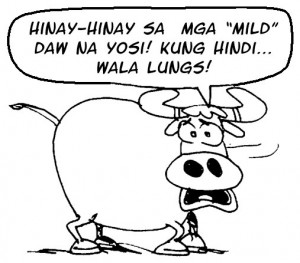
Its tar and other toxic contents, regardless of amount, will accumulate in your lungs and may eventually kill you.
Under a law awaiting the signature of President Aquino, cigarette packs or tobacco packages will no longer carry labels such as “low tar,” “light,” “ultra-light,” “mild,” “extra” and “ultra” that mislead a consumer into thinking the product is not harmful.
This is one of the key provisions of the proposed graphic health warning law that Congress approved before adjourning last week.
Its main aim is to have graphic health warnings on cigarette packs that warn of the “devastating effects” of smoking and passive smoking, and remove misleading claims that tend to convey the product is less harmful than it is.
Local and foreign brands
“The State shall protect and promote the right to health of the people and instill health consciousness among them,” the proposed law says.
It also aims to protect consumers from trade malpractices and from substandard tobacco products.
Once signed by the President, it will apply to tobacco products locally manufactured or imported and introduced in the Philippine market.
Under the World Health Organization’s Framework Convention on Tobacco Control (FCTC), the Philippines has the duty to adopt and implement effective health warnings on tobacco products by September 2008.
Stiff penalties
Section 8 of the measure states that a year after the Department of Health issues the templates, no cigarette pack or package “shall bear any number or descriptor such as ‘low tar,’ ‘light,’ ‘ultra-light,’ or ‘mild,’ ‘extra,’ ‘ultra,’ and similar terms in any language that … misleads a consumer to believe that a tobacco product or variant is healthier, safer or less harmful.”
The proposed law imposes stiff penalties on manufacturers or retailers violating its provisions.
It defines graphic health warnings as photographic images printed on the package that “accurately depict the hazards of tobacco use and [are] accompanied by textual warning related to the picture.”
Picture and text
The warnings, consisting of picture and text, will be printed on 50 percent of the principal display surfaces of any tobacco package. They will occupy 50 percent of the front and back panels of the packaging.
They will be printed using current technology to come up with “vivid and realistic pictures,” and in a color “which contrasts conspicuously with the background of the package,” according to the measure.
A maximum 12 templates of the warnings will be printed simultaneously, and rotated periodically for each brand family and each variant, so that every two years, the variations of the warnings will appear in the market with the same frequency.
Fines up to P2M
The measure imposes individual fines on manufacturers, importers and distributors of tobacco products, as well as their agents, for violation of its provisions.
The penalty ranges from P500,000, on the first offense, to P1 million, on the second offense, to P2 million or imprisonment of not more than five years, or both, on the third offense.
“If the guilty officer is a foreign national, he shall be deported after service of sentence and/or payment of applicable fines … and permanently barred from reentering the Philippines,” the measure says.
The withdrawal from factory or importation of noncompliant tobacco packages constitutes one offense. An additional penalty of P100,000 per day shall be imposed for each day the violation continues after the Department of Trade and Industry (DTI) has issued an order notifying the company of the infraction.
Penalties vs sellers
The proposed law imposes a different set of fines on retailers or sellers, and their agents: P10,000 on the first offense; P50,000 on the second offense; and P100,000 or imprisonment of not more than one year, or both, on the third offense.
Each day that noncompliant tobacco packages are found in the retail establishments after the compliance date constitutes one offense.
An additional penalty of P5,000 is imposed for each day the violation continues after the DTI has issued the order notifying the retailers of the infraction.
Authors of the measure acknowledged that graphic health warnings were shown to be more effective in conveying the truth about the dangers of smoking than text warnings.
RELATED STORIES
Bill for graphic pictures on cigarette packs gains ground
Bill requiring graphic warning on cigarette packs passes committee level
Antismoking pics on packs pushed